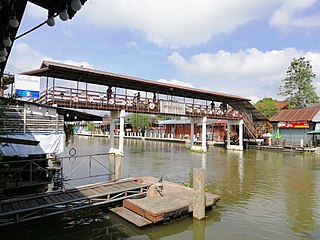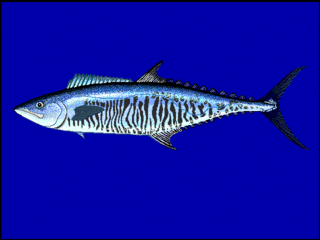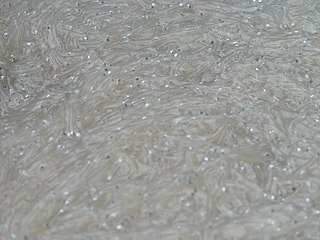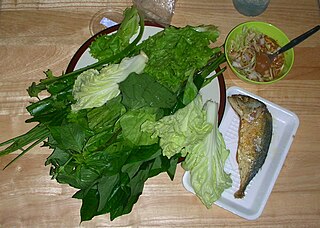
Thai cuisine is the national cuisine of Thailand.

Mackerel is a common name applied to a number of different species of pelagic fish, mostly from the family Scombridae. They are found in both temperate and tropical seas, mostly living along the coast or offshore in the oceanic environment.

Samut Songkhram is one of the central provinces (changwat) of Thailand.

Shrimp paste or prawn sauce is a fermented condiment commonly used in Southeast Asian and Southern Chinese cuisines. It is primarily made from finely crushed shrimp or krill mixed with salt, and then fermented for several weeks. They are either sold in their wet form or are sun-dried and either cut into rectangular blocks or sold in bulk. It is an essential ingredient in many curries, sauces and sambal. Shrimp paste can be found in many meals in Cambodia, Indonesia, Laos, Malaysia, Myanmar, the Philippines, Singapore, Thailand, and Vietnam. It is often an ingredient in dip for fish or vegetables.

Thai curry is a dish in Thai cuisine made from curry paste, coconut milk or water, meat, seafood, vegetables or fruit, and herbs. Curries in Thailand mainly differ from the curries in India in their use of ingredients such as herbs and aromatic leaves over a mix of spices.

Thai fried rice is a variety of fried rice typical of central Thai cuisine. In Thai, khao means "rice" and phat means "of or relating to being stir-fried."

Pla ra, similar to padaek in Laos, is a traditional Thai seasoning produced by fermenting fish with rice bran or roasted rice flour and salt fermented in a closed container for at least six months. Fermented fish seasoning are commonly found in Cambodian, Lao, Mon, Thai and Vietnamese cuisine. Pla ra has a very strong smell, which is considered unpleasant by some people. Its flavors are salty and sour, depending on the amount of salt put in and lactic acid resulting from fermentation process.

The narrow-barred Spanish mackerel is a mackerel of the family Scombridae found in a wide-ranging area in Southeast Asia, but as far west as the east coast of Africa and from the Middle East and along the northern coastal areas of the Indian Ocean, and as far east as the South West Pacific Ocean.

Samut Songkhram Football Club is a Thai professional football club based in Samut Songkhram. The club is currently playing in the Thai League 3 Western region.

Whitebait is a collective term for the immature fry of fish, typically between 25 and 50 millimetres long. Such young fish often travel together in schools along coasts, and move into estuaries and sometimes up rivers where they can be easily caught using fine-meshed fishing nets. Whitebaiting is the activity of catching whitebait.

Rastrelliger is a mackerel genus in the family Scombridae. The three species of Rastrelliger together with the four species of Scomber comprise the tribe Scombrini, known as the "true mackerels".

Senegalia pennata, is a species of plant which is native to South and Southeast Asia. It is a shrub or small tropical tree which grows up to 5 metres (16 ft) in height. Its leaves are bipinnate with linear-oblong and glabrous pinnules. Its yellowish flowers are terminal panicles with globose heads. The pods are thin, flat and long with thick sutures.

Nam phrik is a type of Thai spicy chili sauce typical of Thai cuisine. Usual ingredients for nam phrik type sauces are fresh or dry chilies, garlic, shallots, lime juice and often some kind of fish or shrimp paste. In the traditional way of preparing these sauces, the ingredients are pounded together using a mortar and pestle, with either salt or fish sauce added to taste.

Khanom chin are fresh, thin rice noodles in Thai cuisine which are made from rice sometimes fermented for three days, boiled, and then made into noodles by extruding the resulting dough through a sieve into boiling water. Khanom chin is served in many kinds of stock: coconut milk, fish curry, and chilli. Although chin means "Chinese" in Thai, this type of noodle originated from the Mon people who inhabited the region which is now central Thailand The word khanom chin is probably derived from the Mon words hanom cin, or "boiled noodles."

Kaeng tai pla is a curry of southern Thai cuisine. Its name is derived from tai pla, a salty sauce made from fermented fish entrails, which gives the curry a strong smell and flavor.

Scombrini, commonly called the true mackerels, is a tribe of ray-finned bony fishes in the mackerel family, Scombridae – a family it shares with the Spanish mackerel, tuna and bonito tribes, plus the butterfly kingfish.

Phuket cuisine originates from Phuket, Thailand and has Chinese, Malaysian, and Thai influences.

Anodontostoma chacunda or Chacunda gizzard shad is a small species of gizzard shad found in both fresh and marine waters. The fish is from the family Clupeidae.

Nam Phrik Kapi is a Thai shrimp paste chili sauce known as Nam phrik kapi (Thai:น้ำพริกกะปิ) is a popular representation of dipping sauce in Thailand, particularly central and southern. It matches very well with fried fish, namely mackerel and boiled vegetables such as boiled cabbage or fresh vegetables such as cucumber, eggplants.
The Fishing industry in Thailand, in accordance with usage by The World Bank, the UN's Food and Agriculture Organization (FAO) and other multinational bodies, refers to and encompasses recreational fishing, aquaculture, and wild fisheries both onshore and offshore.



























